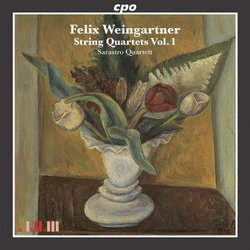| All Artists: Sarastro Quartet Title: Weingartner: String Quartets Vol. 1 Members Wishing: 0 Total Copies: 0 Label: Cpo Records Original Release Date: 1/1/2008 Re-Release Date: 6/24/2008 Genre: Classical Styles: Chamber Music, Historical Periods, Classical (c.1770-1830) Number of Discs: 1 SwapaCD Credits: 1 UPC: 761203725120 |
Search - Sarastro Quartet :: Weingartner: String Quartets Vol. 1
CD Details |
CD ReviewsStunning Quartets! Heruvo | Canada | 07/17/2008 (5 out of 5 stars) "The first quartet is a magnificent work with heart wrenching melodies. While the music is powerful all the way through, I was especially moved by the haunting slow section inside the third movement (allegro molto) and by the "Tema con variazioni". I am not normally partial to the theme-with-variations form, but the expansive theme in this movement sucked me in, and the variations do it justice. I had to work a bit harder on the third quartet, but in my opinion every bit as expressive as the first. The Sarastro Quartet delivers powerful and emotive performances of two quartets that deserve to have a place in the regular quartet repertoire." Worthwhile Romantic-Era Quartets by a Man Primarily Known as J Scott Morrison | Middlebury VT, USA | 07/12/2008 (5 out of 5 stars) "Felix Weingartner (1863-1942; the jewel case erroneously lists his birthdate as 1893) was primarily known as a conductor and he was one of the leading lights of the early electric recording era. He was the first to record all of Beethoven's symphonies, for instance; how I loved his electrifying 'Eroica' from my schoolboy days. But, like many conductors of his and succeeding eras (Furtwängler among them) he considered himself primarily a composer. The record label cpo has in the past few years issued recordings of much of his output and it is my opinion that he was a better-than-most composer; how disappointed he must have been at not having had more acclaim. But perhaps the cpo series can partially rectify that, particularly if they stimulate live performances. I have particularly liked the recordings of his symphonies: Felix Weingartner: Symphony No. 1; König Lear [Hybrid SACD], Weingartner: Symphony 2 [Hybrid SACD], Felix Weingartner: Symphony No. 5 [Hybrid SACD], and even more, the one previous issue of some of his chamber music: Weingartner: Sextet & Octet. The present CDs gives us two of his four string quartets, the Nos. 1 & 3 and both are worthy of inclusion in any modern day quartet's repertoire.
Quartet No. 1, Op. 24, in D Minor, was written in 1898 and premiered by its dedicatees, the then-eminent Halir Quartet. It is in the usual four movements. The first movement is a densely constructed lament for the death of Otto von Bismarck as well as for the young child of friends. It is followed by a movement marked 'Adagio assai' that opens with a sad chorale (A) which is surprisingly interrupted at 1'35 by a lively contrapuntal duple-time section that almost sounds like a scherzo (B). The movement has the form of ABABABA, with each succeeding section having extensive elaborations. A marvelous movement, this. The third movement, Allegro molto, is a true scherzo (albeit highly chromatic) with an idyllic trio section. The finale is a Theme with Variations. The movement has a portentous introduction before the appearance of the almost Schubertian theme and seven variations. The movement (and quartet) concludes with a magnificent fugal treatment of the theme plus material from the first movement. A lovely quartet played with mastery and panache by the heretofore unknown-to-me Sarastro Quartet, which is made up of members of the Winterthur (Switzerland) Collegium Musicum. Quartet No. 3 Op. 34 in F Major comes from 1903, directly after Weingartner married his second wife, Feodora von Dreifuss. The thematic material for much of the quartet comes from the musical notes in his wife's first name: F, E, C ('do'), D ('re'), A. The quartet is in three movements. The first movement plays around with those motto notes before breaking into an odd but exhilarating romp in C sharp minor (and thus almost completely foreign to the opening motto). But then it settles into A minor, a key which contains all the FEODORA notes. Meanwhile, the music is exceedingly contrapuntal and condensed, almost like something by Reger. It took a while for it to make sense to me, but once it did (and once my ear got used to it) it sings passionately. This is indeed a lover's music. The second movement, Allegro molto, makes use of three of the Fedora notes - F, E, A - and with its repetition of melodic cells, amidst harmonic swirls, sounds almost like something by Janácek. It slows down to become the quartet's slow movement, a rocking, crooning lullaby. The finale, after a dreamy slow introduction, is marked Allegro giocoso, which I read as a joke by Weingartner as it is anything but 'jocose'; rather it is sardonic, frantic, and disturbing, with many dark and foreboding sections. One wonders indeed how, if this quartet was dedicated to his new wife, its message is meant to be interpreted. Still, the music qua music is fascinating, pays repeated listening, and is marvelously conveyed by the young Sarastro Quartet. Once again I am impressed by the compositional talents of conductor Weingartner and urge those who are interested in exploring late Romantic quartet literature to give it a try. And I, for one, am eager to hear what is surely coming from cpo and the Sarastro: a CD containing Quartets Nos. 2 & 4. Scott Morrison" |

